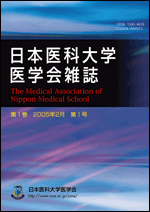Volume 19, Issue 2
Displaying 1-21 of 21 articles from this issue
- |<
- <
- 1
- >
- >|
-
2023Volume 19Issue 2 Pages 70-71
Published: April 20, 2023
Released on J-STAGE: May 27, 2023
Download PDF (339K) -
2023Volume 19Issue 2 Pages 72-77
Published: April 20, 2023
Released on J-STAGE: May 27, 2023
Download PDF (1772K) -
2023Volume 19Issue 2 Pages 78-83
Published: April 20, 2023
Released on J-STAGE: May 27, 2023
Download PDF (1503K) -
2023Volume 19Issue 2 Pages 84-89
Published: April 20, 2023
Released on J-STAGE: May 27, 2023
Download PDF (1156K) -
2023Volume 19Issue 2 Pages 90-95
Published: April 20, 2023
Released on J-STAGE: May 27, 2023
Download PDF (1233K)
-
2023Volume 19Issue 2 Pages 96
Published: April 20, 2023
Released on J-STAGE: May 27, 2023
Download PDF (256K)
-
2023Volume 19Issue 2 Pages 97-102
Published: April 20, 2023
Released on J-STAGE: May 27, 2023
Download PDF (355K) -
2023Volume 19Issue 2 Pages 103-112
Published: April 20, 2023
Released on J-STAGE: May 27, 2023
Download PDF (461K) -
2023Volume 19Issue 2 Pages 113-120
Published: April 20, 2023
Released on J-STAGE: May 27, 2023
Download PDF (388K) -
2023Volume 19Issue 2 Pages 121-129
Published: April 20, 2023
Released on J-STAGE: May 27, 2023
Download PDF (445K) -
2023Volume 19Issue 2 Pages 130-136
Published: April 20, 2023
Released on J-STAGE: May 27, 2023
Download PDF (356K) -
2023Volume 19Issue 2 Pages 137-145
Published: April 20, 2023
Released on J-STAGE: May 27, 2023
Download PDF (413K)
Photogravure
-
2023Volume 19Issue 2 Pages 146-147
Published: April 20, 2023
Released on J-STAGE: May 27, 2023
Download PDF (467K)
Review
-
2023Volume 19Issue 2 Pages 148-155
Published: April 20, 2023
Released on J-STAGE: May 27, 2023
Download PDF (955K) -
2023Volume 19Issue 2 Pages 156-163
Published: April 20, 2023
Released on J-STAGE: May 27, 2023
Download PDF (534K)
Article
-
2023Volume 19Issue 2 Pages 164-170
Published: April 20, 2023
Released on J-STAGE: May 27, 2023
Download PDF (1025K)
Case Report
-
2023Volume 19Issue 2 Pages 171-176
Published: April 20, 2023
Released on J-STAGE: May 27, 2023
Download PDF (1090K)
Talking Point
-
2023Volume 19Issue 2 Pages 177
Published: April 20, 2023
Released on J-STAGE: May 27, 2023
Download PDF (186K) -
2023Volume 19Issue 2 Pages 178-190
Published: April 20, 2023
Released on J-STAGE: May 27, 2023
Download PDF (699K)
-
2023Volume 19Issue 2 Pages 191-192
Published: April 20, 2023
Released on J-STAGE: May 27, 2023
Download PDF (391K)
-
2023Volume 19Issue 2 Pages 193-196
Published: April 20, 2023
Released on J-STAGE: May 27, 2023
Download PDF (296K)
- |<
- <
- 1
- >
- >|
